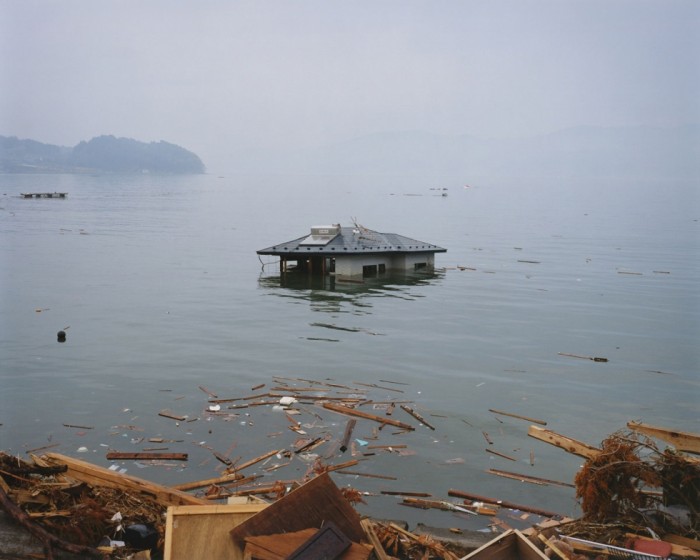[This was posted to LPV Magazine a few days ago, with a whole bunch of images to illustrate some of the books I’m talking about.]
At the 2010 edition of the Higashikawa Photo Festival, I met a photographer named Iino. We were both getting drunk at the annual barbeque, where everyone gets together and eats a bunch of free food. Iino was a fun guy, and as we talked he showed me a project he was working on, a series of portraits in which he was always shaking hands with his subject. The people in these photographs represented a real cross-section of Japan: there were nerds, punks, disabled people, salarymen, children and foreigners. Some people seemed a little surprised or uncomfortable to be photographed in this way, but the mood was light. With a laugh, he said he wasn’t going to stop until he’d taken a thousand of these portraits–a latter-day, unserious August Sander! He pulled out his cheap SLR, took my picture as we laughed together, and then we talked a little more before wandering on. I want to bring up Iino to introduce my thoughts about 2011 because it seems to me that his project represents a kind of photograph that we’re not seeing so much in Japan anymore. To put it simply, I’m wondering if Japanese photographers are losing interest in people.
The March 11 earthquake and its effects will necessarily loom over any attempt to think about Japan’s 2011. These effects are not going away anytime soon, even if it’s entirely too easy for Tokyoites to forget about what’s happening up North. For their part, photographers have made an effort to show people what’s happening in Tohoku, but I’m not sure that much of the work being produced so far is all that useful to anyone. I think it’s possible that my general disappointment with post-3/11 photographs so far could be linked to a broader turn away from representing people in Japanese photography.
I don’t want to go down the path of “the old days were so much better,” but if you look at photographers like Hiromi Tsuchida and Kazuo Kitai, their primary interest was other people–and I think this was not so much because of something “beautiful” or “interesting” in the people themselves, but because they could produce some kind of effect by showing these people to an audience. Tsuchida’s “Counting Grains of Sand” is an easy example of what I’m talking about. The book examines crowds in 1980s (“bubble”-era) Japan, building up from groups of just a few people to a fairly dramatic conclusion, in which hundreds of faces are packed into the frame. Outside of Hiroh Kikai, it’s hard to think of prominent and contemporary Japanese photographers who are equally interested in people; Kikai himself is probably more respected outside of Japan anyway.
A newer type of photography, represented by Rinko Kawauchi and Masafumi Sanai, favors abstract, object-based explorations. I like this work: I recently found a used copy of Sanai’s “Ikiteru” the other day, and I think it’s very good. But I don’t think this type of photography is well-suited to deal with something like a natural disaster which is affecting hundreds of thousands of people. I haven’t been moved by his recent work, but I really respect Daido Moriyama for saying in this video [skip to the 50 minute mark] that, from the beginning, he decided absolutely to not shoot any earthquake-related photographs, because it wouldn’t make any sense for him personally. What a sensible thing to say! Meanwhile the amateur shooters at ROLLS TOHOKU have been showing up most professionals, for the simple reason that they are able to show us people in a natural way.
Asahi Camera Magazine published a special magazine of post-3/11 photography, and it sums up the weak response. The photographs mostly show objects and houses, to varying degrees of poignancy. I can’t understand why these photographs are all that we’re seeing. I want to know what people are doing!
Hirokawa Taishi’s series of family portraits is the one exception here. His portraits of families living in evacuation centers are the most powerful photographs in this magazine. Perhaps it makes sense that a guy who had thought for years about the ‘craziness’ of nuclear reactors in Japan would come up with a good response.
I am still convinced that the most useful photographs to come out of this disaster will not even be taken for years, because the scale of the destruction is so big. I want to know how relocated families are integrating into their new communities, whether or not people are rebuilding their homes next to the coast, how long people will be living next to rubble. Is photography even the right way to find these things out?
A few months ago, I had a small job shooting some event photos. I got to the place, saw Iino on the other side of the crowd. He was shooting for a newspaper, but I caught up with him later and asked him how the project was going. He said something to the effect of, “after the earthquake, it’s not a good time to be taking those photos, is it?” I told him that, given everything that’s happened, it might actually be the perfect time, but it didn’t look like that was going to change his mind.



















